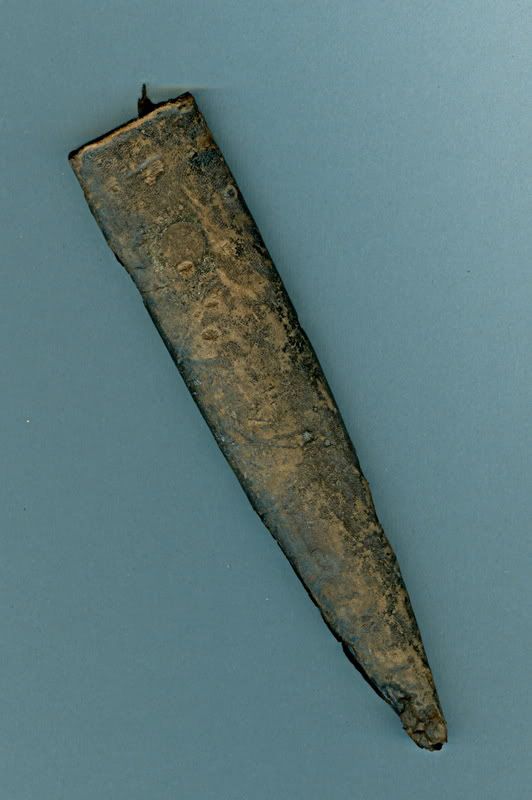
 |
|
|
#1 |
|
Member
Join Date: Dec 2004
Location: Sint-Amandsberg (near Ghent, Belgium)
Posts: 830
|
I found this one yesterday on a Belgian auction site. I think it comes from the Sudan. It has a 'Mahdist' feel to it with the Arabic inscriptions on the blade.
It was the blade which interested me. Has anyone seen this on an African blade ? Looks Indian to me, or am I wrong ? Length is 27 cm. I'll send better pics when it arrives. 
|
|
|

|
|
|
#2 |
|
Member
Join Date: Dec 2004
Location: What is still UK
Posts: 5,807
|
Nice and very interesting! When you get it post better pictures showing the script.

|
|
|

|
|
|
#3 |
|
Member
Join Date: Dec 2004
Location: Sint-Amandsberg (near Ghent, Belgium)
Posts: 830
|
Looks old, no ?

|
|
|

|
|
|
#4 |
|
Member
Join Date: Dec 2004
Location: What is still UK
Posts: 5,807
|
Looks old and African, if I say Sudan it will be in the old sense of the word far more than the "Mahdi" "Omdurman" and all that.
|
|
|

|
|
|
#5 |
|
Arms Historian
Join Date: Dec 2004
Location: Route 66
Posts: 9,945
|
This dagger is most definitely Sudanese, and probably an early to mid 20th century interpretation of those fashioned by Mahdist armourers during those conflicts. The basic form reflects the kindjhals often carried by Turco-Egyptian troops, which was often imitated by local smiths and an example of this exact type blade is shown in the catalog for the Kendall Collection exhibition (Linz & Schallaberg, Austria, 2001-2002).
The bifurcated blade of course is intended as an interpretation reflecting the very sacred Sword used by Muhammed, Dhu'l Faqar, and the thuluth script acid etched on the blade is typical of those on Sudanese edged weapons associated with the Mahdist period |
|
|

|
|
|
#6 |
|
Member
Join Date: Dec 2004
Location: What is still UK
Posts: 5,807
|
Freddy, I have just gambled on this. I do believe I can see a version of the inscription "The conqueror, salvation unto him" so we both have things to compere. I have a similar axe pretty much the same size 26 inches long but without the copper? inlay.
|
|
|

|
|
|
#7 |
|
Arms Historian
Join Date: Dec 2004
Location: Route 66
Posts: 9,945
|
"...axes were popular among the Mahdist troops, and many were used in the butchery of Khartoum when the city fell"
"...some had elegant crescent shaped blades", further, "...the grips are normally wrapped in crocodile skin". "Ten Years of Captivity in the Mahdis Camp" F.R.Wingate, Cairo, 1892 A highly decorative example has its entire surface covered with elaborate acide etched 'thuluth' with additional brass calligraphic inlays. Kendall, 2001 |
|
|

|
|
|
#8 |
|
Member
Join Date: Dec 2004
Location: Sint-Amandsberg (near Ghent, Belgium)
Posts: 830
|
Nice axe, Tim.
As promised here are the pics. I just received the piece and it looks great. I hope someone can read the text. It still has its original leather covered wooden scabbard. This knife is sharp and functional.     
|
|
|

|
|
|
#9 |
|
Member
Join Date: Dec 2004
Location: What is still UK
Posts: 5,807
|
Looks good and old to me. Very nice. I should be working but I sold some work yesterday and to my amazement got payed. So my discipline has gone astray today.
I think the script is a version of this. I believe the version seen on weapons like this is not the most pure form however when one thinks of its use as decoration freely applied as we see here, some artistic license should be expected. Note the first symbol at the bottom rather like a number 3 round the wrong way. The axe should be with me Tuesday. |
|
|

|
|
|
#10 |
|
Arms Historian
Join Date: Dec 2004
Location: Route 66
Posts: 9,945
|
Most interesting guys, thanks very much.
|
|
|

|
|
|
#11 |
|
Arms Historian
Join Date: Dec 2004
Location: Route 66
Posts: 9,945
|
Tim, just noticed the reference you're using......thanks again
 and I hadn't thought of checking that . Actually the 'thuluth' script is indeed actually more decorative than distinctly applied calligraphy, and was used in imitation of the beautiful metalwork on Mamluk weapons of Egypt and I hadn't thought of checking that . Actually the 'thuluth' script is indeed actually more decorative than distinctly applied calligraphy, and was used in imitation of the beautiful metalwork on Mamluk weapons of EgyptLooking forward to pics of the axe....and its great to see some good Sudanese weapons posted! Best regards, Jim |
|
|

|
|
|
#12 |
|
Member
Join Date: Dec 2004
Location: What is still UK
Posts: 5,807
|
Arrived today. No idea about the inlay script.
|
|
|

|
|
|
#13 |
|
Member
Join Date: Feb 2006
Posts: 637
|
The problem with reading many inscriptions on Sudanese pieces is that a lot of it was badly copied from the koran. Often you will see the inscription starting in the middle of a sentence and ending when they ran out of room. Often more talisman and decorative than anything else
|
|
|

|
|
|
#14 |
|
Arms Historian
Join Date: Dec 2004
Location: Route 66
Posts: 9,945
|
Nice axe, of Mahdist style. It appears that the 'thuluth' and brass inlay is representative of the weapons of Mamluk heritage, and was probably favored in a talismanic or amuletic sense.
|
|
|

|
 |
|
|